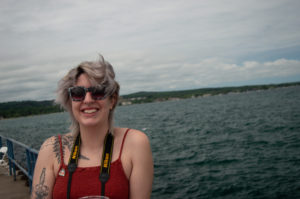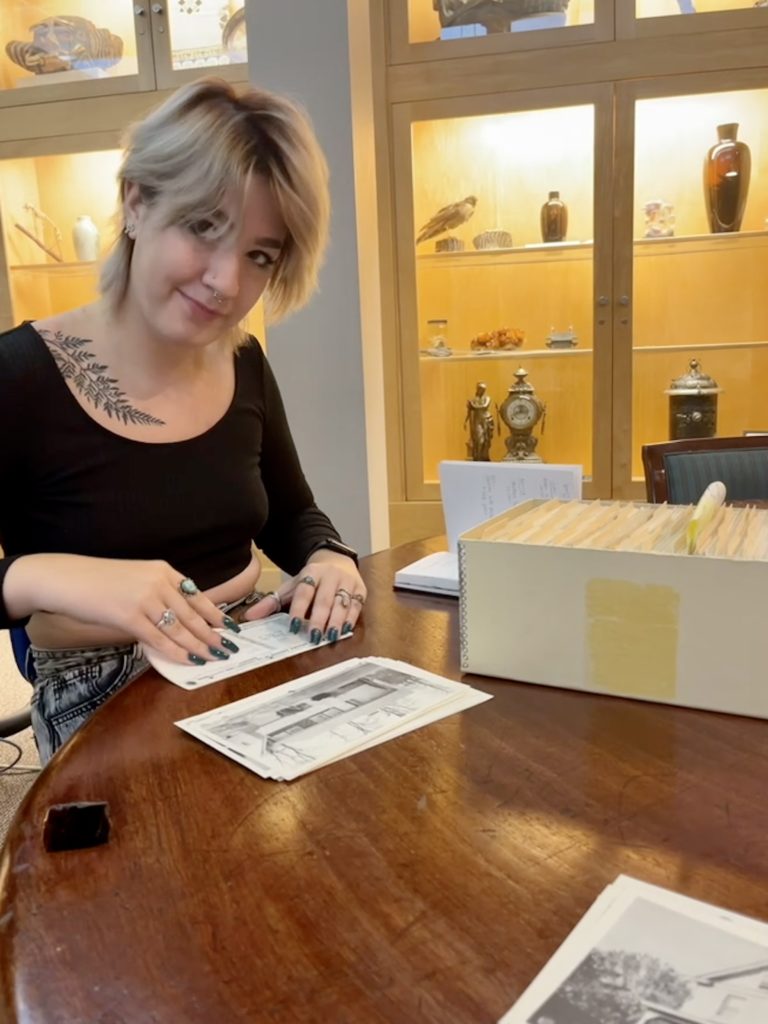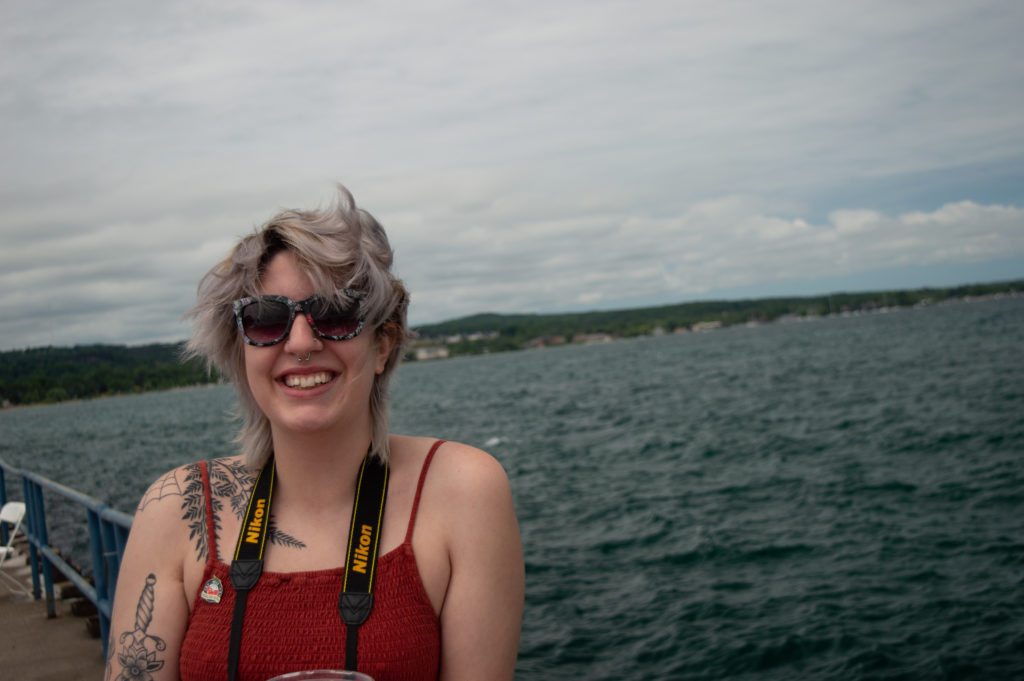FotoFocus Biennial Project Intern Highlight
Posted on August 9, 2022
Australian artist Ian Strange will create new photographic and film works while completing an Artist in Residence program with FotoFocus at the Art Academy of Cincinnati. The residency includes a student internship program, and Ellie Wallace, painting and drawing major at the Art Academy of Cincinnati, shares her experience as one of the nine paid interns assisting with the Ian Strange project throughout the summer.
Previously on THE LENS, we spoke with Australian artist Ian Strange for a Q&A and featured Romaiza Nadeem, student at the Art Academy of Cincinnati (AAC) and one of the nine paid interns assisting with Strange’s project throughout the summer. The internship program provides hands-on opportunities for AAC students from the initial development to realizing the final exhibition and installation. Students self-selected areas of interest and are working with Strange’s team during each stage of the project, including archive/research development, pre-production, site prep, community engagement, documentation, and post-production.
According to Strange, the research and archive aspect informs the direction of the project. He said, “until we’ve completed the research on the houses and started work, it is hard to say where the focus will be […] It’s about research and then letting the site inform the work.” The research and archive team, led by Lacey Haslam, Executive Assistant at the Art Academy of Cincinnati, has utilized a variety of resources to learn about the project sites such as local newspaper archives, Ancestry.com, and the Hamilton County Auditor’s website.
Make sure to see the final artworks displayed in the FotoFocus curated exhibition, Ian Strange: Disturbed Home, at the Art Academy of Cincinnati’s SITE 1212 and the Annex this fall, as well as the FotoFocus Participating Venue exhibition, I Don’t Know How To Love You: The Relationship Between Humans and Nature in the AAC Pearlman Gallery.
Below, AAC student Ellie Wallace shares her experience working on this project:
My name is Ellie Wallace and I am a senior at the Art Academy of Cincinnati. I major in painting and drawing, with a double minor in printmaking and creative writing. I came to Cincinnati from Ellettsville, Indiana, after graduating high school in 2019. I come from a big family, a small town, and a “whole ‘lotta love.”
I became involved in the Ian Strange project after my mentor, Lacey Haslam, introduced me to the project. Lacey and I share similar interests, so when she told me about it, I knew I had to do it. After the first meeting and when I learned what some of our responsibilities were, I knew I needed to commit one hundred percent; opportunities like this don’t just walk through the door everyday.

My main commitment has been to the research and archive aspect of the project. I chose this as my main focus because it involved a lot of nosiness. Research led to rabbit holes and rabbit holes led to answers. I started my research with the Hamilton County Auditor’s website, which led to me looking at Ancestry.com, which then led me to Newspapers.com. I found some amazing articles on Newspapers.com relating to either one of the houses or people connected to the house. We were able to build connections between families and homes and see the life that happened in these spaces. I got to read about a lot of joy: how one family at the Epworth location was involved in the radio boom in Cincinnati, how a cop at Epworth saved people and stopped crime, the lives of military personnel at Ley, and so much more. Unfortunately, with the joyous stories also came some not so joyous moments of death, loss, and crime. There cannot be good without the bad, however, and that is important to keep in mind with a project like this one. It is all of those things that have built these lives that we are uncovering. To only include the good would not be truthful depictions of the families or the communities in which the projects took place.
I’ve spent a lot of time learning about the houses, the neighborhoods, and the people of these sites. I’ve also had amazing help from Mickey DeVise, a research librarian at the Cincinnati Museum Center (CMC), and Arabeth Balasko, a curator at the CMC. At the CMC, I was able to look at newspaper scrapbooks, books, maps, and old photos that have been donated to the Cincinnati archive. The most exciting parts for me are books and old photos. There is so much intention with books, and to see books that have been preserved since the 1700s was incredible. There was a book written by the man who first started purchasing property from the Native Americans. The book was small, green, and used old English, but it was cool to see such an old artifact about the city. Then seeing photos at the Geier Collections and Research Center , I got to see the history of Cincinnati and how the city has grown. Personally, I have a lot of interest in finding the people in the photos or the books and uncovering their lives and what has been recorded about them. I’m really interested in history and truth and [how] we as humans choose to communicate that. The archive collection gave us so many resources for Strange, as well as inspiration for me as an artist.
I’ve also helped a little bit with site preparation and community engagement. Site prep was exciting because it’s what I thought I would want to do most, but ended up not being the case. I admittedly had more fun doing research and archiving. For site prep, however, we assisted the Art Department from the production company to get the houses ready for the shoot, the idea being that we are leaving them better than how we found them. Community engagement has been focused on getting with the neighbors and informing them of the project, the shoot, and asking them for stories or photos of the neighborhood. I joined this team later on, once my part on the research and archive team started to wind down, so [that] I could still be involved with the project. Linnea [Gartin] and Romaiza [Nadeem] have been super welcoming [with] getting me onboarded and introduced to the neighborhood.


(Photo credit: Lacey Haslam); Wallace behind-the-scenes at one of the locations for site prep (Photo credit: John Michael Ramsey).
The most challenging aspect of the project has been coordinating with multiple people from so many different organizations. Throughout the project, we’ve collaborated with the AAC, FotoFocus, the production company, and all the archive locations, among others. As a student, I have to work to support myself. In the beginning, it was challenging to ensure others involved with the project understood that I still have a commitment to my other job and am only available on certain days. I still need for my bills to be paid and to have food to eat. At times, I felt dismissed as “just an intern” when it came to some aspects. There was a lot to keep track of so communication was key. I knew this was going to be a learning process, but I believe it still needs to be noted because it was true to my experience. Overall, more transparency with students would be very beneficial to the program.
That’s not to discredit any part of the internship, however. I wouldn’t have traded anything for this experience—it has been so rewarding. I have insight on where I want to go with my own career, I’ve gathered resources I can use moving forward, and made connections with others associated with the project. It has been incredibly beneficial to be a part of a team and learn how to delegate and complete tasks on an agenda, and communicate with Strange and his team to make sure he’s getting the information he needs for the exhibition.
Aside from this, I am getting ready for a busy fall semester. I am going into my senior year and preparing for shows throughout the semester, beginning with Where Things Stand, a group exhibition at the AAC in the Pearlman Gallery opening August 26. Additionally, I helped curate a FotoFocus show, I Don’t Know How To Love You: The Relationship Between Humans and Nature, as part of a class offered last semester at the AAC. It will open on September 30th in the Pearlman Gallery. I’m working with [Lacey] Haslam on the Norman [Kattleman Archive] Project, an archive project she is doing for FotoFocus as well, and other various shows and commissions.
Finally, I am working on some other projects in my studio: painting, printmaking, and exploring textiles. I am creating works that incorporate different areas of interest exploring ideas of identity, home, self, and memory. It is important to me to be working on my studio practice no matter how busy my schedule becomes because it is my career, afterall.
